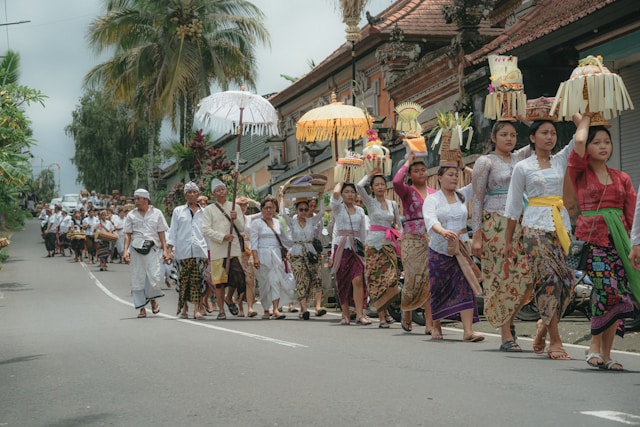Understanding Odalan Bali truly opens a window into the island’s vibrant spiritual heart. This experience often begins unexpectedly. Imagine strolling down a quiet Balinese lane. The air smells sweet, pervaded by incense that whispers through frangipani trees. Suddenly, a wave of hypnotic sound washes over you. It is the metallic pulse of a Gamelan orchestra.
As you draw closer, a temple appears transformed. Usually a place of serene contemplation, it now bursts with a kaleidoscope of color. Tall, gracefully swaying penjor poles, adorned with intricate coconut leaf creations, reach for the heavens. Offerings pile high like mountains of devotion. A community, dressed in their finest traditional attire, moves with a palpable sense of joyful purpose. Indeed, this is very likely an Odalan. This is Bali’s beautiful and profoundly significant temple anniversary festival. It’s more than just an event; it connects directly to the very heartbeat of Balinese spirituality. We at Merusaka Nusa Dua would be delighted to share a little of its magic with you.
What is an Odalan? More Than Just a Temple’s Birthday
“Temple birthday” offers a simple way to think of it. However, an Odalan (or Piodalan) holds much deeper meaning. It represents a sacred and joyous period. It marks the anniversary of a specific temple’s consecration or original founding. This is a hallowed time. Balinese people believe the deities, revered ancestors, and guardian spirits intrinsically linked with that temple descend from the heavens. They grace their earthly home with their presence. They eagerly await the community’s devotion and offerings. Understanding Odalan Bali means grasping this deep spiritual connection.
The Unique Rhythm of the Pawukon Calendar
One fascinating aspect that makes Bali so rich with ceremony is the timing of Odalan. These celebrations do not follow the Gregorian calendar. Instead, the 210-day Balinese Pawukon calendar dictates their dates. Thousands upon thousands of temples exist across the island. These range from the smallest family shrines to grand village temples. Each celebrates its own Odalan according to this unique cycle. Consequently, a vibrant ceremony is almost always taking place somewhere in Bali! It’s a continuous, beautiful rhythm of devotion. It underpins the spiritual life of the island. For visitors, respectfully witnessing an Odalan often becomes a delightful and serendipitous part of their Bali experience.
The Heartfelt Purpose of an Odalan: Welcoming the Divine
The intentions behind an Odalan are multi-layered and deeply spiritual:
- Welcoming and Honoring the Divine: Primarily, it is a time to warmly welcome and pay homage to the temple’s resident deities and deified ancestors. It invites them to be present amongst the community and receive heartfelt gratitude. This is a core part of understanding Odalan Bali.
- Purification and Renewal: The festival involves important rituals. These aim at ritually cleansing and re-consecrating the temple itself. This process renews its sacred energy and reaffirms its sanctity.
- Expressing Gratitude for Blessings: It provides a powerful collective opportunity for the temple congregation (pengempon) and the wider village community. They offer profound thanks for all blessings bestowed upon them. These include good health, bountiful harvests, family well-being, or communal prosperity.
- Strengthening Connections and Harmony: Odalan are immense community efforts. They beautifully reinforce the vital bonds among people, their gods, their ancestors, and the natural world. This reflects the core Balinese philosophy of Tri Hita Karana – the three causes of well-being that promote harmony.
A Feast for the Senses: The Sights and Sounds of an Odalan
Approaching a temple during its Odalan is like stepping into a realm vibrant with devotion, artistry, and communal spirit. It truly offers an immersive feast for all your senses!
A Temple Dressed in its Festive Finest
The temple transforms, adorned with magnificent and symbolic decorations:
- Penjor: These iconic, tall, gracefully arching bamboo poles are a signature sight. They are similar to those seen during Galungan, but sometimes feature variations unique to the temple or specific Odalan. They reach towards the sky. They are lavishly decorated with young coconut leaves (janur), fruits, flowers, and rice cakes. They symbolize prosperity and gratitude to the divine.
- Lamak, Umbul-umbul, and Kober: Look for the intricately woven palm-leaf hangings called lamak. They often feature symbolic religious designs. They adorn shrines and gateways. Tall, slender banners known as umbul-umbul flutter elegantly in the breeze. Smaller, triangular flags called kober add to the vibrant and sacred atmosphere. They represent the power of the deities.
- Offerings Galore (Banten): Perhaps one of the most visually stunning aspects involves the breathtaking array of elaborate offerings (banten). Community members spend days, sometimes weeks, meticulously crafting these beautiful towers. They also arrange fruits, flowers, intricately folded palm leaves, colorful rice cakes (jaja), and other symbolic items. These are not mere decorations. Instead, they represent heartfelt, artistic gifts presented to the divine. You can learn more about the philosophy of daily offerings here. This rich visual element is key to understanding Odalan Bali.
The Movement and Melodies of Devotion
The atmosphere at an Odalan also fills with captivating movement and sounds:
- Graceful Processions (Mapeed or Melasti): Often, you will witness elegant processions connected to the Odalan. The Mapeed presents a particularly beautiful sight. Individuals, dressed in their finest traditional attire (often spectacular matching kebaya and sarong), walk in a graceful, single-file line towards the temple. They reverently carry offerings piled high on their heads. Sometimes, leading up to a major Odalan, a purification procession called Melasti takes place. This involves the community carrying sacred temple heirlooms and effigies (pratima) to the sea or a holy spring for ritual cleansing. It truly is an evocative and significant spectacle.
- The Enchanting Sound of Gamelan: The air around an Odalan almost constantly vibrates with the mesmerizing sounds of the Gamelan orchestra. The intricate, percussive melodies originate from bronze metallophones, gongs, drums, and flutes. They are not merely background music. They integrate into every ritual. Different types of Gamelan ensembles play specific music. This music welcomes the deities, accompanies sacred dances, and elevates the spiritual atmosphere of the temple.
- Sacred Dances (Wali & Bebali) as Offerings: Many Odalan ceremonies feature special sacred dances. Performers present them within the temple courtyards. These primarily serve as ritual offerings, not entertainment like tourist performances. They please and honor the visiting divine beings. You might witness the profound Topeng Pajegan (a sacred solo mask dance often performed by a priest, embodying different characters), the graceful Rejang Dewa (a serene, devotional dance performed by young women or girls, welcoming the gods with their gentle, flowing movements), or various forms of Baris (sacred warrior dances depicting divine protectors). These Wali (most sacred, performed in the innermost courtyard) and Bebali (ceremonial, in the middle courtyard) dances differ from the Balih-balihan (secular or entertainment) dances one might see at dedicated tourist shows.

A glimpse of Bali’s living tradition. Sacred processions like this are not just rituals—they are the heartbeat of the island.
The Vibrant Spirit of Community
Above all, an Odalan powerfully and joyfully expresses community. You will observe generations working together harmoniously. People might construct temporary shelters, prepare ritual implements, or play in the Gamelan. Others often focus on crafting intricate offerings and preparing food for communal meals. Everyone, young and old, usually wears their best traditional clothing. They share a sense of purpose, devotion, and social connection. It truly forms a beautiful tapestry of shared faith.
Key Rituals and Activities: Moments of Sacred Devotion
While each Odalan can feature unique characteristics, some key elements consistently appear. These variations depend on the specific temple and local traditions. These rituals prove central to understanding Odalan Bali at a deeper level.
- Purification Rites: The festival usually begins with rituals aimed at purifying the temple grounds. This includes its shrines and sacred objects. It prepares for the arrival of the deities.
- Welcoming the Divine: Specific prayers, enchanting Gamelan music, and sometimes dance performances create an atmosphere. They formally invite and welcome the gods and ancestral spirits. They encourage them to descend and be present.
- The Heart of the Offering: Families and individuals then formally present their meticulously prepared banten (offerings). This happens at various shrines and altars throughout the temple complex. This represents a deeply personal and communal act of giving.
- Communal Prayers (Muspa): The temple congregation gathers for collective prayer sessions. The local temple priest (Pemangku) often leads these. For larger and more significant Odalan, a high priest (Pedanda) might lead. These moments foster shared focus, reverence, and devotion.
- Receiving Holy Water (Tirta Wangsuh): After the main prayer cycles, devotees often receive blessings. This comes as tirta (holy water). The priest sprinkles this water on them. They may also sip a small amount and apply it to their head and body. This offers a form of purification and blessing.
- Sacred Performances as Offerings: As mentioned earlier, specific sacred dances and Gamelan music integrate into the ritual. Performers present them as offerings. They honor and entertain the visiting divine beings.
- Deeper Ceremonial Observances: Other profound traditional rituals might also take place. These occur within the sanctity of the temple. Some originate from very ancient practices. They aim at ensuring cosmic balance and appeasing all natural and supernatural forces. These represent sacred internal aspects of the ceremony. They hold deep meaning for the community.
- Sharing Blessed Food (Lungsuran): Often, after the main prayer cycles complete, a joyful sense of communal feasting and socializing follows. Food that has been offered to the deities gains blessings (lungsuran). Community members then share it. This symbolizes shared blessings, abundance, and togetherness.
Observing an Odalan Respectfully: Being a Gracious Guest
Experiencing an Odalan, even as an observer, can truly become a deeply moving and memorable part of your Bali visit. Balinese people are generally very welcoming. They are often happy to share their culture. However, visitors must approach with genuine respect and cultural sensitivity. Your respectful presence is key to truly understanding Odalan Bali.
Is it Okay to Visit? Accessing Sacred Spaces
Generally, yes! Visitors are often welcome to observe Odalan ceremonies from the outer courtyards (jaba sisi or jaba tengah) of the temple. The innermost, most sacred area (jeroan) typically reserves for those actively participating in prayers and specific rituals. If a temple gate is open and people are entering, you can usually respectfully observe from the appropriate areas.
Dress Code is Absolutely Paramount: Showing Respect
This point cannot be stressed enough. It shows your deep respect for the sacred space and the ongoing ceremony. Always wear a sarong and a sash (selendang). Ensure your shoulders are covered. No tank tops, sleeveless shirts, or very short shorts are allowed. This applies to everyone. Many larger temples offer these for rent or a small donation if you arrive unprepared. However, it’s always thoughtful and appreciated to have your own simple sarong.
Your Demeanor Matters Greatly During an Odalan: Respectful Conduct
Your behavior in the temple is very important. Therefore, always keep these guidelines in mind:
- Be Quiet and Unobtrusive: Remember, this is a sacred religious ceremony, not a tourist show. Keep your voice very low. Avoid loud conversations or laughter. Move around quietly and slowly.
- Don’t Obstruct Pathways: Never walk in front of people who are praying. Be mindful not to block pathways used by processions or those carrying offerings. Find a spot on the periphery to observe.
- Photography with Sensitivity: If you wish to take photos, please be very discreet. Never use a flash, especially during prayers or rituals. It is highly disruptive and considered disrespectful. It is always polite to ask for permission before taking close-up photos of individuals. This is especially true if they are engaged in a ritual or prayer.
- Consider Your Sitting Position: If you are seated, particularly on the ground, try not to point your feet directly towards the shrines, priests, or important offerings. Feet are considered impure. People often sit cross-legged, or with their feet tucked neatly behind them. Crucially, never position yourself higher than a priest or significant offerings. If a priest is seated on the ground, visitors should also sit on the ground.
Special Considerations for Observing: Cultural Nuances
- A Note for Women: Balinese tradition kindly requests that menstruating women refrain from entering temple grounds. This stems from cultural beliefs about ritual purity. You should respect this custom.
- Follow Local Guidance: Temple guardians (pecalang) are sometimes present. They often wear distinctive traditional attire. Their role involves maintaining order and guiding visitors. Please respectfully follow any instructions or guidance they might give.
- Offering a Small Donation (Dana Punia): While not usually mandatory for simply observing from an accessible area, making a small, voluntary donation (dana punia) when visiting a temple is a kind and appreciated gesture. This is particularly true during an Odalan. This helps with the significant costs of temple upkeep and hosting these elaborate ceremonies. You will often find a clearly marked donation box.
- Appreciate the Authenticity: Remember you are witnessing a living tradition. It is a deeply spiritual and communal event. It holds great meaning for the local people. Approach it not as a spectacle to be consumed. Instead, approach it with genuine interest, humility, and an open heart. Your respectful presence usually receives a warm welcome.
Conclusion: A Window into Bali’s Living Soul
An Odalan is so much more than just a colorful festival. It’s a vibrant, deeply spiritual, and wonderfully communal celebration. It forms the very backbone of religious life in countless Balinese temples throughout the year. It’s a time when art, devotion, community spirit, and gratitude intertwine beautifully. This creates an atmosphere that is uniquely Balinese.
Encountering an Odalan offers a unique and precious opportunity. Perhaps it even happens by chance during your explorations of Bali. It lets you witness living Balinese culture in its most authentic and heartfelt form. You can also feel the palpable pulse of the island’s spiritual life and the strong bonds of its communities. Understanding Odalan Bali gives you a deeper appreciation for this experience.
We hope that by understanding a little more about what an Odalan entails, you can appreciate its beauty and significance even more deeply. This is especially true should you have the chance to observe one. Ultimately, the key involves always approaching with respect, an open heart, and a willingness to witness something truly special.
Should you be interested in learning more, or if you hear the captivating sounds of Gamelan nearby and are curious, our concierge team at Merusaka might sometimes be aware of larger, more accessible community temple Odalans in the vicinity. This is an option if observing respectfully is something you’d like to experience (and if appropriate for visitors). Enjoy the magic and profound spirit of Bali!



